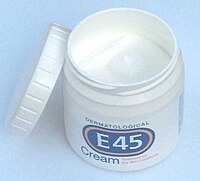
Photo from wikipedia
The objective of the current study is to evaluate the prospective of liquisolid formulation to improve the dissolution rate of ketoprofen and thereby the bioavailability. Different batches of liquisolid were… Click to show full abstract
The objective of the current study is to evaluate the prospective of liquisolid formulation to improve the dissolution rate of ketoprofen and thereby the bioavailability. Different batches of liquisolid were prepared using polyethylene glycol 200 as a solvent, microcrystalline cellulose, and aerosil 200 as carrier and coating material, respectively. Central composite design (32) was utilized to examine the effects of independent variables (load factor and excipient ratio) on dependent variables (solubility and % in vitro drug release). Differential scanning calorimetry, Fourier transform infrared spectroscopy, X-ray diffraction, and scanning electron microscopy techniques were employed for characterization of optimized batch (LS-10) of liquisolid formulation. The half-maximal inhibitory concentration (IC50) values for in vitro anti-inflammatory activity for liquisolid formulation exhibited a higher anti-inflammatory effect than ketoprofen and physical mixture. The statistical analysis of in vivo (anti-inflammatory and analgesic) activities data demonstrated that the test (optimized formulation) treatment group resulted in quick pharmacological response in Wistar rats and Albino mice when compared with standard (pure drug) and control treatment groups. The results obtained in the present study illustrated that the liquisolid formulation could be a propitious approach to increase the bioavailability of ketoprofen and could be used in oral therapy.
Journal Title: Drug delivery and translational research
Year Published: 2022
Link to full text (if available)
Share on Social Media: Sign Up to like & get
recommendations!